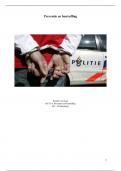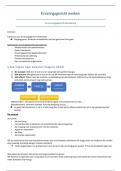Preventie en bestraffing
Rosalie van Laar
RC-314: Preventie en Bestraffing
B3 – Criminologie
1
,Literatuurlijst
Probleem 1
Aebi, M., Delgrande, N. & Marguet, Y. (2015) Have community sanctions and measures
widened the net of the European criminal justice systems? Punishment & Society, 17(5) 575-
597. DOI: 10.1 177/1462474515615694Downes, D. & Swaaningen, R. van (2007). The road
to dystopia? Changes in the penal climate of the Netherlands. Crime and Justice, 3(1), 31-71.
Boone M. (2021). Van zelfdwang naar zachte macht: Civilisatie slokt emancipatie
op. Justitiële Verkenningen, 47(2), 40-57.
Cohen, S. (1979). The punitive city. Notes on the dispersal of social control. Crime, Law and
Social Change, 3(4), 339-363.
Garland, D. (2001). The Culture of Control. Crime and social order in contemporary
society. New York: Oxford University Hoofdstuk 1 en 8.
Feeley, M.M. and Simon, J. (1992). The new penology: notes on the emerging strategy of
corrections and its implications. Criminology, 30(4), 449-474.
Malsch, M. (2018) De afnemende rol van de rechtspraak: is vervanging van de rechter
mogelijk en wenselijk? Justitiële Verkenningen, 44(4), 49-63.
Molleman T. (2021). Toen en nu: Heeft het gevangeniswezen de middelen om zijn doelen te
bereiken? Justitiële Verkenningen, 47(2), 24-39.
Peeters, R. (2015). The price of prevention: The preventative turn in crime policy and its
consequences for the role of the state. Punishment & Society, 17(2), 163-183.
Schuilenburg, M. (2019). De veiligheidsutopie voorbij? Over geborgenheid en valse vrijheid.
In Pragmatisch verzet tegen cultuurpessimisme: In gesprek met het oeuvre van Hans
Boutellier (pp. 155-168). Boom bestuurskunde.
Shearing, C.D. & Stenning, P.C. (1984). From the Panopticon to Disney World: The
development of discipline. In A.N. Doob & E.L. Greenspan (Eds.), Perspectives in Criminal
Law: Essays in Honour of John LL.J. Edwards (pp. 335-349). Ontario: Canada Law Book
Inc. Via: https://www.researchgate.net/publication/324662094Links to an external site..
Swaaningen, R. van (2013). Reversing the punitive turn. The case of the Netherlands. In T.
Daems, S. Snacken & D. van Zyl Smith (eds.). European Penology (pp. 339-360). Oxford:
Hart.
Swaaningen, R. van (2021) Civilisatie en emancipatie, maar van wie precies?: Twee eeuwen
gevangen dertig jaar later. Justitiële Verkenningen, 47(2), 10-23.
Woude, M. van der (2015). (On)veiligheid en efficiacy als stabiel kompas voor het
strafrechtelijk criminaliteitsbeleid. Tijdschrift voor Criminologie, 57(1), 111-126.
Probleem 2
Boone, M. (2016). Effectiviteit van straffen. In M. Boone & C. Brants (red.), Criminologie en
Strafrecht (pp. 201-228). Den Haag: Boom Juridische uitgevers.
Cohen, S. (1979). The punitive city. Notes on the dispersal of social control. Crime, Law and
Social Change, 3(4), 339-363 à al bij probleem 1.
Edgemon, T. G., & Clay-Warner, J. (2019). Inmate mental health and the pains of
imprisonment. Society and Mental Health, 9(1), 33-50.
Goffman, (1968). Asylums: Essays on the social situation of mental patients and other
inmates. Londen: Penguin Books Ltd. Delen uit hoofdstuk 1 [Canvas].
Mears, D. P., & Cochran, J. C. (2018). Progressively tougher sanctioning and recidivism:
Assessing the effects of different types of sanctions. Journal of Research in Crime and
Delinquency, 55(2), 194-241.
Petrich, D. M., Pratt, T. C., Jonson, C. L., & Cullen, F. T. (2021). Custodial sanctions and
reoffending: A meta-analytic review. Crime and Justice, 50(1), 353-424.
Phelps, M.S. and Ruhland, Ebony L. (2022) Governing Marginality: Coercion and Care in
Probation. Social Problems, 69, 799–816.
Tollenaar, N., Beerthuizen, M. G. C. J., Drieschner, K. H., & van der Laan, A. M.
(2019). Effectiviteit van de ISD-maatregel. Den Haag: WODC. (2e replicatie).
2
,Probleem 3
Braga, A. A., Turchan, B., Papachristos, A. V., & Hureau, D. M. (2019). Hot spots policing of
small geographic areas effects on crime. Campbell Systematic Reviews, 15(3).
Eck, J. E., & Clarke, R. V. (2019). Situational crime prevention: Theory, practice and
evidence. In Handbook on crime and deviance (pp. 355-376).
Cozens, P & Love, T (2015) A Review and current status of crime prevention through
environmental design (CPTED) Journal of Planning Literature. Vol 30(4) (pp.393-412).
Douglas, S. & Welsh, B.C. (2022) There has to be a better way: place managers for crime
prevention in a surveillance society, International Journal of Comparative and Applied
Criminal Justice, 46:1, 67-80, DOI: 10.1080/01924036.2020.1788960.
Probleem 4
Bellanova, R. & de Goede, M. (2022) The algorithmic regulation of security: An
infrastructural perspective. Regulation & Governance, 16, 102–118
Brayne, S., & Christin, A. (2021). Technologies of crime prediction: The reception of
algorithms in policing and criminal courts. Social Problems, 68(3), 608-624.
Donkin, S. (2014). Preventing terrorism and controlling risk. A comparative analysis of
control orders in the UK and Australia. Springer-Verlag New York. Pp. 79-88 ( 7).
McCulloch, J. & Wilson, D. (2016). Pre-crime: Pre-emption, precaution and the
future. Routledge London and New York. H1, p. 1-12.
Mugari, I. & Obioha, E.E. (2021) Predictive Policing and Crime Control in The United States
of America and Europe: Trends in a Decade of Research and the Future of Predictive
Policing. Social Sciences 10: 234.
Simmons, R. (2016) Quantifying Criminal Procedure: How to Unlock the Potential of Big
Data in our Criminal Justice System. Michigan State Law Review 947, 947-1017.
Schuilenburg, M. & Soudijn, M. (2023) Big data policing: The use of big data and algorithms
by the Netherlands Police. Policing: A Journal of Policy and Practice, 2023, 17, 1–9
Podcast: Nog één keer over de toeslagenaffaire (De Rudi & Freddie Show) (45 min.)
3
, Probleem 1 – Een nieuwe kans? 1950-2021
Probleem 1.1
Literatuur:
Cohen, S. (1979). The punitive city. Notes on the dispersal of social control. Crime, Law and
Social Change, 3(4), 339-363.
Garland, D. (2001). The Culture of Control. Crime and social order in contemporary society.
New York: Oxford University Press. Hoofdstuk 1 en 8.
Feeley, M.M. and Simon, J. (1992). The new penology: notes on the emerging strategy of
corrections and its implications. Criminology, 30(4), 449-474.
Shearing, C.D. & Stenning, P.C. (1984). From the Panopticon to Disney World: The
development of discipline. In A.N. Doob & E.L. Greenspan (Eds.), Perspectives in Criminal
Law: Essays in Honour of John LL.J. Edwards (pp. 335-349).
Leerdoelen:
1. Wat is er sinds de jaren 50 veranderd in het denken over en de aanpak van
criminaliteit/daders?
2. Hoe zijn deze ontwikkelingen te verklaren?
Uit: Cohen, S. (1979). The punitive city. Notes on the dispersal of social control.
The punitive city
o Een concept van Cohen waarbij de gemeenschap bijdraagt aan de aanpak van
criminaliteit d.m.v. sociale controle.
The dispersal of social control
o De verspreiding van beheersingsmechanismen in de samenleving.
Transformaties aan het einde van de 18e eeuw en het begin van de 19e eeuw: from prison to
community
o Ontwikkelen van een centrale staat: verzorgingsstaat; de controle van criminaliteit en
zorg voor afhankelijken wordt gecentraliseerd.
o Het begrip dat verschillende soorten criminelen bestaan waarvan verschillende
experts eigen kennis hebben.
o Een verhoogde scheiding tussen devianten en afhankelijken die elk door een andere
instantie geholpen worden.
VB: onderscheid tussen psychiatrische ziekenhuizen en gevangenissen.
Een kijk op de gevangenis
o Eind 18e eeuw: gevangenis = laatste redmiddel
o Midden 19e eeuw: gevangenis is de eerste plek waar je terecht komt na een misdrijf
o Eind jaren ’60: gevangenis = laatste redmiddel
Gevolg: meer decarceration: er kwamen steeds minder gevangenissen en
bestaande gevangenissen werden gesloten. Vaker een toepassing van
community sanctions, want gevangenissen zouden niet effectief en humaan
zijn.
Twee assumpties die leidden tot decarceration en meer community sancties:
o Gezond verstand: drie soorten bewijs dat community sancties beter zijn:
Gevangenis = ineffectief, rehabiliteert niet en schrikt niet af – is soms juist
een netwerk om meer criminele vaardigheden te verwerven
Community sancties zijn goedkoper: denk aan taakstraf
Community sancties zijn menselijker
o Sociologische/politieke opvattingen:
Deviantie vindt zijn oorsprong in de samenleving en daarom moet preventie
en genezing ook in de samenleving plaatsvinden
4





